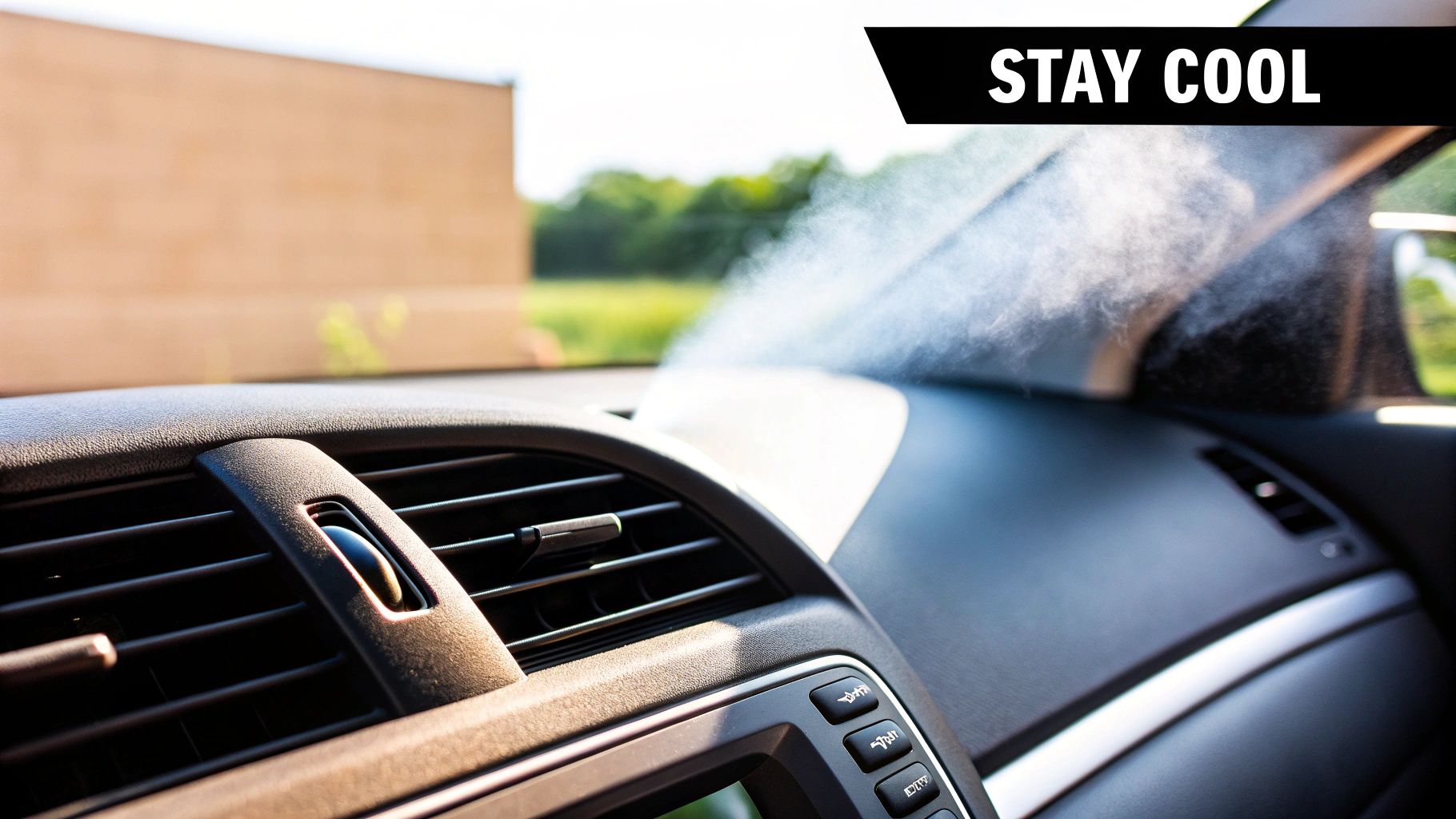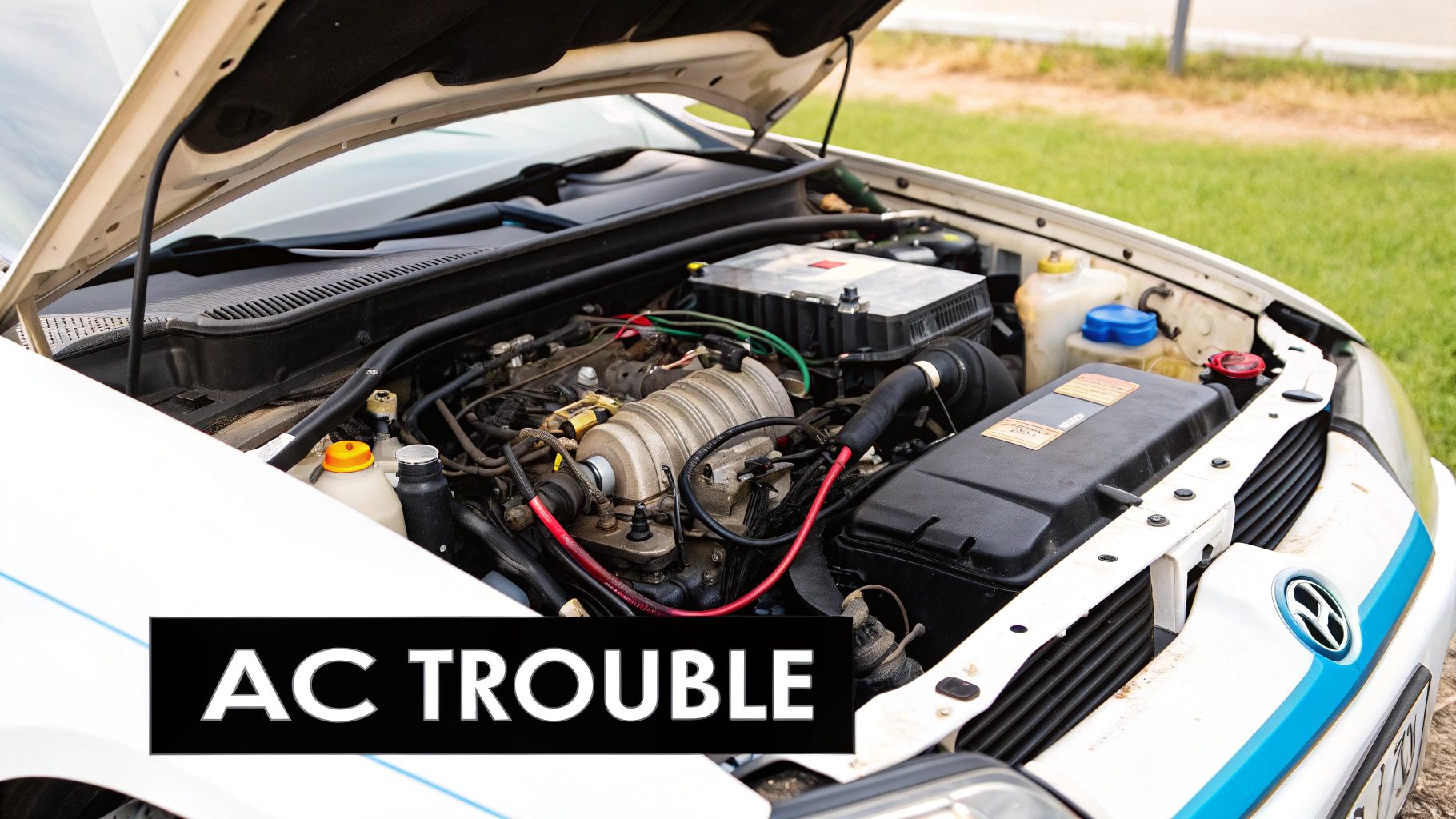UK Car Air Conditioning Service Cost Explained
- coledem
- Aug 2
- 10 min read
When your car’s air con stops blowing cold, the first question that pops into your head is usually, "How much is this going to set me back?" Let's break it down.
On average, a basic car air conditioning service, which most people call a 'regas', will cost you somewhere in the ballpark of £100 here in the UK. That figure is not just pulled out of thin air; it is a mix of the labour charges (what the garage charges for their time) and the cost of the refrigerant gas itself.
What Is The Average Car AC Service Cost In The UK?

It is one of those jobs where the price is not fixed across the board. The final bill you see is a combination of two key elements: the technician's time and the gas they put in your system. Labour rates for an AC service typically land between £30 and £50, but the real variable is the refrigerant.
The gas itself can range from around £35 to well over £100. This swing in price comes down to your car's make and, crucially, the specific type of refrigerant it was designed to use. For a deeper look at how garages arrive at these figures, this cost guide from Checkatrade.com is a great resource.
Here is a table outlining what you might expect to pay for different types of air con services.
Estimated UK Car AC Service Costs at a Glance
A summary of typical costs for different car air conditioning services in the UK, helping you quickly compare prices.
Service Type | Average Cost Range |
|---|---|
R134a Regas Service | £50 - £80 |
R1234yf Regas Service | £120 - £200+ |
Full AC Service (Inc. Anti-Bacterial Clean) | £80 - £150 |
Leak Detection & Repair (Labour + Parts) | £70 - £300+ |
Keep in mind these are just estimates. The final price can change based on your location, the specific garage, and whether any extra repairs are needed.
The Two Types of Refrigerant
The biggest single factor influencing your regas price is the kind of refrigerant your car needs. Pretty much every car on UK roads will use one of two main types:
R134a Refrigerant: This was the industry standard for years. If your car was made before 2017, it almost certainly uses R134a, which is the cheaper of the two.
R1234yf Refrigerant: This is the newer, more environmentally friendly gas. It's been mandatory in all new vehicles since 2017, but it's more complex to produce, making it significantly more expensive.
A simple regas for an older car using R134a can be a fairly cheap job. If your newer vehicle needs R1234yf, expect a noticeably higher bill purely because of the cost of that gas.
Knowing which gas your car uses is half the battle. You can usually find this information in your vehicle's handbook or on a sticker under the bonnet. This simple check gives you a solid baseline for what routine maintenance should cost, before we even get into what happens when things actually break.
What Affects the Final Price of Your AC Service?

When it comes to the car air conditioning service cost, you'll quickly realise there is no single, fixed price. The final figure on your bill can be quite different from the next person's, and it all comes down to a few key variables.
Think of it like this: a high-performance or luxury car often has a more sophisticated air conditioning system tucked away deep in the engine bay. Getting to these components simply takes more time and effort, which naturally adds to the labour cost.
The type of refrigerant your car uses is probably the biggest single factor. As we have mentioned, there is a significant price gap between the older R134a gas and the newer, environmentally friendlier R1234yf. If your car was made after 2017, it almost certainly uses the more expensive gas, so the starting price for a regas will be higher.
Location and Labour Rates
It also matters where you get the work done. A garage's labour rates often reflect their local overheads. You might find that a workshop in a busy city centre has to charge more per hour than a trusted independent garage in a town like Sandy or Biggleswade.
A garage's hourly rate is a core part of the final bill, especially if the job turns into more than a straightforward regas. It is always a smart move to ask for a clear quote that breaks down the labour charges before agreeing to any work.
It's also common for garages to have a separate diagnostic fee. This comes into play if a regas does not fix the issue. This fee covers the technician’s time and the specialist equipment needed to hunt down hidden problems, like a tricky leak or a failing electrical part. Staying on top of your car's general maintenance can sometimes prevent these surprises, a topic we cover in our guide on why regular car service matters.
Any extra parts or repairs needed will naturally add to the cost. A standard service might reveal a few common issues that need sorting:
A dirty or clogged cabin filter that needs replacing.
Tell-tale signs of a leak that require UV dye and more investigation.
Wear and tear on belts or hoses linked to the AC compressor.
What a Proper AC Service Actually Involves
A lot of drivers think an air-con service is just a quick "top-up," but a professional job is much more thorough. When you understand what is happening under the bonnet, you start to see why the car air conditioning service cost is a worthwhile investment. It is not just about getting cold air back; it is about checking the health of the entire system to prevent bigger bills down the road.
First things first, a technician will run a performance check. They will pop a thermometer in your air vents to get a baseline reading of how well (or not) your system is cooling. This is followed by a good visual once-over, checking key parts like the compressor, belts, and hoses for any obvious cracks, leaks, or wear and tear.
Next comes what I consider the most critical step: the vacuum test. The mechanic will hook your car up to a machine that sucks all the air and moisture out of the AC system, creating a vacuum. They then shut it off and watch the pressure gauge. If that pressure starts to creep back up, it is a dead giveaway that you have got a leak somewhere. There is absolutely no point adding expensive new gas until that leak is found and fixed.
The Regas and System Refresh
Once the system has proven it can hold a vacuum, the old refrigerant and lubricant oil are recovered. These fluids lose their effectiveness over time, so getting the old stuff out is necessary for a proper refresh.
Then comes the "regas" itself. The system is recharged with the precise amount and type of new refrigerant gas and lubricating oil, all according to your car manufacturer’s exact specifications. Getting this wrong—too much or too little—can cause serious damage, so it has to be spot on.
This image breaks down the main stages of a full service quite nicely.

As you can see, each step builds on the last to make sure the job is done right, from the initial checks right through to the final recharge.
A good garage might suggest a couple of optional extras that are genuinely useful. These often include:
Antibacterial Treatment: This is a deep clean for the system's evaporator and vents. It gets rid of the bacteria and mould that cause those horrible musty smells.
Pollen Filter Replacement: Think of this as the lungs of your car's cabin. A dirty, clogged filter chokes the airflow, forcing your fan and AC to work much harder. A fresh one means better air quality and a more efficient system.
For a deeper look at keeping your climate control in top shape, have a look at our guide on essential car air conditioning care tips.
When a Service Becomes an Expensive Repair
You drop your car off for a straightforward air con regas, expecting a quick and affordable fix. Then you get that phone call from the garage. This is the moment a simple service can spiral into a much more involved and costly repair. It usually happens when the initial vacuum test, which is standard procedure, uncovers a leak or points to a failed part.
There is simply no point in pumping expensive new refrigerant into a system that cannot hold it; it is like trying to fill a bucket with a hole in it. The gas will just escape, and you will be back to square one. UK data shows this is a growing headache for drivers, with the average air con repair claim soaring by 55% in just one year to hit £501. The most frequent culprits are always more expensive to fix than a basic service.
Common AC System Failures and Their Costs
So, if a standard service won't cut it, what has usually gone wrong? More often than not, it is one of these key components, and replacing them involves more time, labour, and pricier parts.
Leaky Condenser: Think of the condenser as the radiator for your air con. It sits right at the front of the car, making it a prime target for stone chips and road debris. It is the single most common major AC repair, making up 54% of claims and typically costing over £300 to replace.
Failing Compressor: The compressor is the heart of the whole system, pumping the refrigerant around. When it gives up, you have got no cold air, period. Swapping one out is a big job, and you can expect the bill to climb past £350.
Damaged Hoses or Seals: Your AC system is a network of hoses and seals that can become brittle and crack over time. This leads to slow, frustrating leaks. While a new hose or seal might not be expensive, the labour to pinpoint the exact source of the leak can really add up.
If your air con is blowing warm air rather than just feeling a bit weak, it is often a tell-tale sign of a more serious issue. Do not ignore it! If your car's AC is not cold enough, our guide can help you understand the potential causes before you even book a service.
Spotting these problems during a routine check is the best way to stop a minor niggle from turning into a major, wallet-draining repair down the line.
How to Save Money on Car AC Maintenance

Keeping your car air conditioning service cost under control is not about luck; it is about good habits. A few simple, proactive steps can help you sidestep those eye-watering repair bills and keep your system running smoothly for years to come.
Here is an easy one: run your air con for a few minutes every couple of weeks, even when it is cold outside. This little trick keeps the refrigerant and oil moving through the system, which is key for lubricating the seals. Well-lubricated seals won’t dry out and crack, which is a common cause of refrigerant leaks.
Be Proactive and Shop Around
It always pays to shop around before you book a service. Do not just go with the first garage you find. Ring up a few different places—independent specialists and main dealers alike—to get a feel for the going rate in Bedfordshire.
You should also ask about bundling services. Many workshops, including ours, are happy to offer a package deal if you get your AC service done at the same time as your annual MOT or other routine maintenance. Combining jobs often works out cheaper. Plus, staying on top of essential car maintenance tips in general helps prevent a whole range of problems, not just with your air con.
Spotting trouble early is your best defence. Listen for strange noises from the vents or notice if the airflow feels weaker than usual. Catching these signs can mean the difference between a simple fix and a costly component replacement.
When it comes to costs, UK car air conditioning repairs can vary wildly. A straightforward re-gas might only set you back £60-£80, but if the whole system needs replacing, you could be looking at a bill for over £1,500. These strategies are all part of a bigger picture of smart car ownership, and you can learn more in our detailed guide on https://www.krauseautos.co.uk/post/how-to-save-on-car-repairs-smart-tips-for-all-drivers-2025.
Your Car AC Questions Answered
Got questions about your car's air conditioning? You are not alone. Let's clear up some of the most common queries we hear from drivers, giving you the straightforward answers you need.
How Often Should I Get My Air Con Looked At?
As a rule of thumb, it is a good idea to book a car air conditioning service every two years. This is not just a random suggestion. Your AC system naturally loses a bit of its refrigerant gas over time – roughly 10% each year. As the gas level drops, so does its cooling power. A regular service does not just top up the gas; it replenishes the oils that keep the system's moving parts lubricated and running smoothly.
What's the Deal with R134a and R1234yf Gas?
These are the two main types of refrigerant you will find in cars today. R134a is the old-school standard, used in pretty much every car made before 2017. The new kid on the block is R1234yf, a much more environmentally friendly gas that is legally required in all new cars manufactured from 2017.
The main thing you need to know is how it affects your wallet. R1234yf is far more expensive to produce, which is the single biggest reason the car air conditioning service cost for a newer car is significantly higher.
Can I Just Regas My Car AC Myself?
While you can pick up DIY regas kits from motor factors, it is a job best left to the professionals. A proper service is much more than a simple top-up. We perform a full vacuum to remove moisture, check for leaks, and add the precise amount of new gas and lubricating oil. Getting it wrong can damage your system, and handling refrigerant gases requires specialist equipment and training to comply with environmental laws.
Does Running the Air Con Really Use More Fuel?
In a word, yes. Your engine has to work a little harder to power the AC compressor, so you will see a slight increase in fuel consumption. On most modern cars, the effect is pretty minimal and you might barely notice the drop in MPG. A healthy, well-maintained system is always the most efficient, putting far less strain on your engine than one that is low on gas and struggling to keep you cool.
If you've got more questions or think it's time for a professional check-up, the team at Krause Autos is always here to help with honest advice and expert service. You can book your car air conditioning service with us today at https://www.krauseautos.co.uk.





Comments